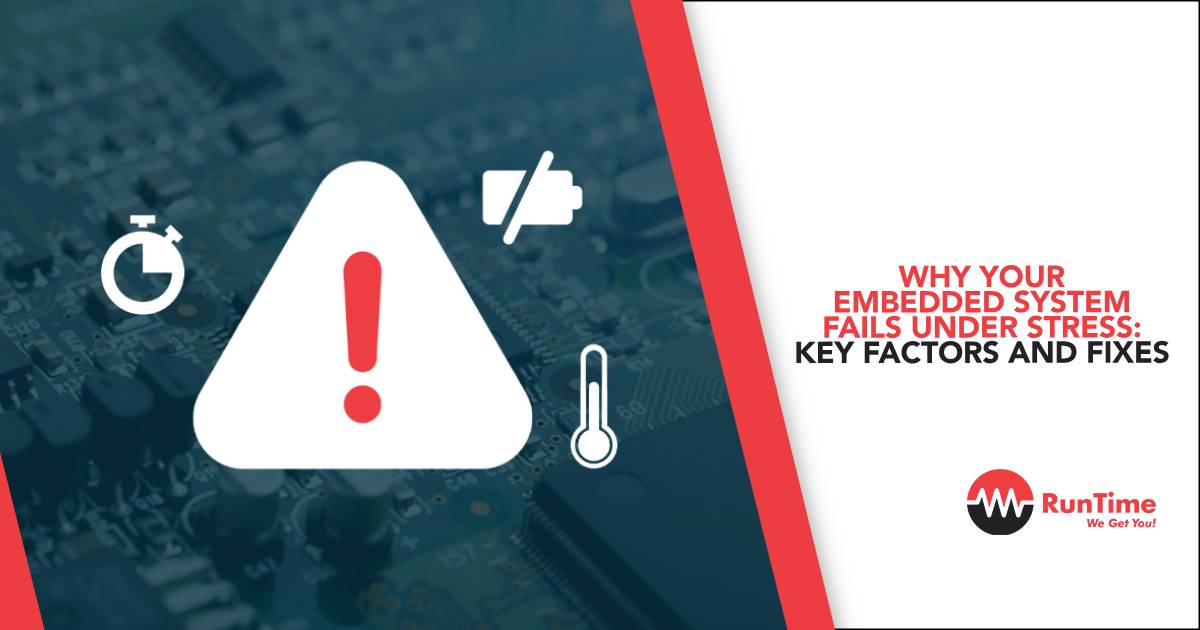Embedded systems are at the heart of modern technology, powering devices from IoT gadgets to critical medical and industrial equipment. These systems often operate under strict performance and reliability constraints. However, when subjected to stress—be it high computational loads, extreme environmental conditions, or prolonged operation—embedded systems can fail in ways that are often unpredictable and catastrophic.
Understanding why embedded systems fail under stress and how to prevent these failures is essential for engineers who design, build, and maintain them. This article explores the key factors contributing to failures under stress and provides actionable fixes to ensure your embedded system can withstand even the most demanding conditions.
What Happens to Embedded Systems Under Stress?
Stress in embedded systems can arise from several sources:
- High Computational Load: Intensive processing tasks, such as real-time data analysis or encryption, can strain the CPU, memory, and peripherals.
- Environmental Extremes: Temperature, humidity, vibration, and electromagnetic interference (EMI) can degrade system performance.
- Prolonged Operation: Continuous operation over extended periods can expose latent issues, such as memory leaks, component aging, or thermal cycling.
- Power Supply Variations: Voltage fluctuations, transients, or unstable power sources can destabilize the system.
Under stress, embedded systems may experience:
- Crashes or resets.
- Degraded performance.
- Communication errors between peripherals.
- Sensor inaccuracies or loss of data integrity.
- Complete system failure.
Key Factors Behind Embedded System Failures
1. Insufficient Power Supply
A stable and sufficient power supply is critical for embedded systems. Stress conditions can exacerbate power-related issues, such as:
- Voltage Drops: High loads can cause voltage dips, leading to brownouts.
- Noise and Transients: Electrical noise or transients can corrupt signals or reset the system.
- Undersized Components: Capacitors, regulators, or power delivery traces may not handle peak current demands.
Fixes:
- Add decoupling capacitors near power pins of ICs to filter noise and stabilize voltage.
- Use low-dropout (LDO) regulators or switching regulators to ensure stable power delivery.
- Oversize components, such as capacitors or inductors, to handle peak currents.
- Use power monitoring ICs to detect and respond to undervoltage or overvoltage conditions.
2. Thermal Overload
Heat is one of the most common stressors in embedded systems. High processing loads, power inefficiencies, or poor thermal design can lead to overheating, which affects:
- Microcontroller or microprocessor performance (thermal throttling).
- Component reliability due to thermal cycling or degradation.
- Solder joint integrity.
Fixes:
- Improve heat dissipation with heat sinks, thermal pads, or active cooling (e.g., fans).
- Optimize firmware to reduce power consumption during idle periods (e.g., sleep modes).
- Use components rated for higher temperature ranges.
- Design PCBs with thermal vias and copper pours to spread heat effectively.
3. Memory Bottlenecks
Memory issues become prominent under stress, particularly in systems with limited RAM or non-volatile storage. Common problems include:
- Heap and Stack Overflows: High computational loads can cause the stack or heap to exceed allocated memory.
- Memory Leaks: Continuous allocation without proper deallocation can exhaust memory over time.
- Fragmentation: Inefficient memory usage can lead to fragmentation, reducing usable memory.
Fixes:
- Analyze memory usage using tools like FreeRTOS memory profiling or static analyzers.
- Implement efficient memory allocation strategies, such as pooling or static allocation.
- Monitor stack and heap usage during runtime and optimize code to prevent overflows.
- Perform regular stress testing to identify and fix memory leaks.
4. Timing and Synchronization Issues
Stress can expose latent timing and synchronization problems in embedded systems, including:
- Missed Deadlines: Real-time tasks may miss deadlines under high CPU or I/O loads.
- Interrupt Latency: Excessive interrupts can delay critical tasks.
- Race Conditions: Concurrent access to shared resources can lead to unpredictable behavior.
Fixes:
- Use real-time operating systems (RTOS) to prioritize and manage tasks effectively.
- Minimize interrupt usage and use Direct Memory Access (DMA) for data transfers.
- Implement mutexes or semaphores to prevent race conditions in shared resources.
- Profile system timing using tools like oscilloscopes or RTOS-aware debuggers.
5. Environmental Stress
External factors like temperature, humidity, vibration, and EMI can cause embedded systems to fail. Examples include:
- Corrosion or shorts due to moisture.
- Component dislodgement due to vibration.
- Signal degradation from EMI or crosstalk.
Fixes:
- Use conformal coatings or potting compounds to protect PCBs from moisture and dust.
- Design PCBs with proper trace spacing and grounding to minimize EMI.
- Secure components with adhesives or vibration-damping materials.
- Use shielded cables and connectors to protect against EMI.
6. Communication Failures
Peripherals communicating via UART, SPI, I²C, or other protocols can fail under stress due to:
- Noise on communication lines.
- Timing mismatches between devices.
- Buffer overflows in firmware.
Fixes:
- Add pull-up or pull-down resistors for I²C and SPI lines to stabilize signals.
- Use termination resistors for high-speed communication lines to reduce reflections.
- Increase buffer sizes in firmware to handle peak data rates.
- Validate communication timing using logic analyzers.
7. Software Bugs and Poor Error Handling
Firmware is often a weak link in embedded systems under stress. Issues like:
- Unhandled exceptions or errors.
- Inefficient algorithms causing high CPU usage.
- Faulty error recovery mechanisms.
Fixes:
- Implement robust error handling to gracefully recover from faults.
- Use watchdog timers to reset the system in case of firmware lock-ups.
- Optimize algorithms for efficiency and avoid blocking functions in real-time tasks.
- Test edge cases and error scenarios during development.
8. Component Aging and Wear
Long-term operation can degrade components like capacitors, batteries, or mechanical parts. Stress accelerates this wear, leading to intermittent or permanent failures.
Fixes:
- Select high-quality components rated for the expected operating life.
- Use redundant components or backup systems for critical operations.
- Perform regular maintenance and replace components prone to wear, such as batteries.
- Design systems to monitor and report component health (e.g., battery voltage, capacitor ESR).
Diagnosing Failures Under Stress
Efficient diagnosis is key to resolving stress-induced failures. Here’s a step-by-step approach:
Step 1: Reproduce the Issue
- Stress the system using tools like:
- CPU-intensive workloads (e.g., cryptographic operations).
- Environmental chambers for temperature and humidity testing.
- Electromagnetic interference (EMI) injectors.
- Monitor the system for failures under specific conditions.
Step 2: Isolate the Problem
- Use divide-and-conquer techniques to isolate the subsystem causing the failure:
- Test individual components, such as power supplies, sensors, or communication modules.
- Use test firmware to bypass unrelated functions.
Step 3: Monitor System Parameters
- Use debugging tools:
- Oscilloscope: Analyze power supply stability and signal integrity.
- Logic Analyzer: Inspect communication protocols for timing or data issues.
- Thermal Camera: Identify hotspots on PCBs.
- Log system states before and during failures for detailed analysis.
Step 4: Analyze Root Causes
- Review firmware logs, memory usage, and task timing.
- Inspect hardware schematics and PCB layouts for design flaws.
- Check components for physical damage or aging.
Step 5: Implement and Test Fixes
- Apply fixes iteratively, addressing one issue at a time.
- Retest the system under stress conditions to ensure stability.
Preventing Failures: Best Practices
1. Design for Reliability
- Use derating principles: Select components rated for higher-than-expected conditions.
- Add redundancy for critical systems, such as dual power supplies or mirrored memory.
2. Perform Thorough Testing
- Conduct stress tests early and often during development.
- Use automated test frameworks for continuous integration and validation.
- Test edge cases, including unexpected inputs and environmental extremes.
3. Optimize Firmware
- Profile and optimize CPU and memory usage.
- Implement robust error recovery and watchdog mechanisms.
- Use modular code to isolate and test individual functions.
4. Ensure Robust PCB Design
- Use ground planes and proper trace spacing to minimize noise and EMI.
- Add test points for debugging and monitoring.
- Design for thermal management with heatsinks, thermal vias, and copper pours.
Real-World Case Studies
Case Study 1: IoT Sensor Node Fails Under High Load
Problem: A battery-powered IoT device experienced random resets during high-load data transmissions.
Diagnosis: Voltage measurements revealed dips in the power supply due to insufficient bulk capacitance.
Solution: Added bulk capacitors and optimized firmware to stagger data transmissions.
Case Study 2: Communication Errors in Industrial Controller
Problem: An industrial controller failed intermittently in noisy environments.
Diagnosis: EMI from nearby motors was inducing noise on the UART lines.
Solution: Added shielded cables and improved PCB trace routing to reduce noise coupling.
Case Study 3: Thermal Shutdown in Edge AI Device
Problem: An AI inference device overheated under prolonged operation.
Diagnosis: Insufficient heat dissipation from the CPU caused thermal throttling and eventual shutdown.
Solution: Added a heatsink and reconfigured the firmware to enable low-power modes during idle periods.
Conclusion
Stress-induced failures are a significant challenge in embedded system design, but they also present an opportunity to create more robust, reliable, and resilient systems. By understanding the key factors that contribute to failures under stress and applying targeted fixes, embedded engineers can ensure their systems operate flawlessly even in the harshest conditions.
Through rigorous testing, careful design, and continuous optimization, you can build embedded systems that stand the test of time and exceed expectations in real-world applications. The key is to anticipate potential failure points early and design with reliability in mind.









